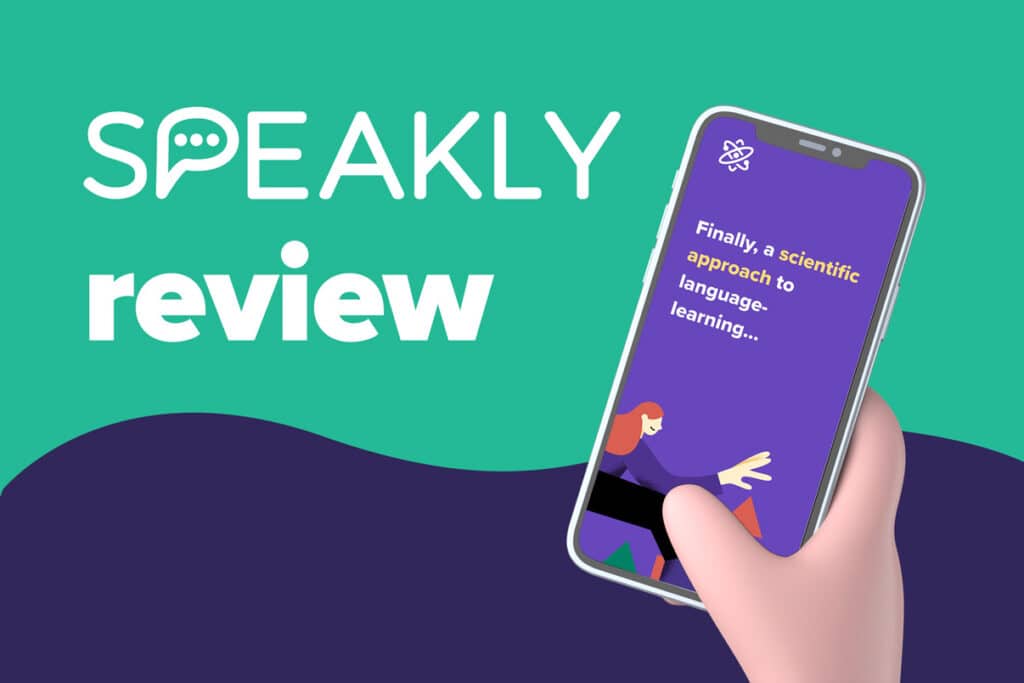
Complete Speakly Review for 2024: Effective but Feels Too Basic at Times
Speakly claims that its users achieve fluency faster through the program compared to its competitors. I needed more convincing, and with an upcoming trip to a Baltic country, I thought it’d be a good idea to study Estonian.
I also looked into Spanish for this review, since it’s a language I’ve studied for a long time.
Overall, I found the program to be easy to use and effective, but I really missed authentic content, video content and the fun visual elements found in some other leading language learning programs.
Overview

Name: Speakly
Description: Estonian statistics-based language learning app.
Languages offered: eight languages including Spanish, French, English, Russian, Estonian, Finnish, Italian and German.
Offer price: Monthly subscriptions from $9.99
Summary
While the statistics based approach is refreshing for a language learning program and get users learning and talking quickly, the lack of video, authentic content and fun visual elements can make it seem a little basic.
- User friendliness - 9/109/10
- Delivers on promises - 8/108/10
- Authenticity - 3/103/10
- Value - 9/109/10
Pros
- Has unusual languages like Estonian and Finnish
- Helps you to speak useful sentences after just a lesson or two
- Introduces new vocabulary in context
- Music section is unique
- Word Bank is helpful for review
Cons
- Steep learning curve
- Not enough variation in lesson types
- Not enough visual elements
- No video content
- Not enough authentic media
Contents
- What Is Speakly?
- Key Features of Speakly
- The Pros of Speakly
- The Cons of Speakly
- Speakly Versus Other Programs
- Is Speakly Worth It?
- And One More Thing...
Download: This blog post is available as a convenient and portable PDF that you can take anywhere. Click here to get a copy. (Download)
What Is Speakly?
Speakly is an Estonian-based holistic language learning program and app that claims you can achieve fluency five times faster than with other apps. They say with this program, you can achieve fluency in a new language in 100 hours—and 42% fluency in just 10 hours.
Designed to be used by anyone from A1 to advanced learners, at its heart, Speakly is a vocabulary app that uses spaced repetition to help you remember the 4,000 most used words in the same order as their real-life statistical relevance.
After years of research, teaching, learning and translating in many different languages, Ott Ojametts and Ingel Keskpaik started Speakly in 2018. Since then, the app has garnered a lot of praise, growing its user base every year.
Key Features of Speakly
My Classroom — Track Your Progress
This is essentially a personalized dashboard, where you go to keep up with your progress and see how much learning you’ve done. It’s also where you track how many words you’ve learned and what level you’re currently on. You navigate to every other section from this home base.
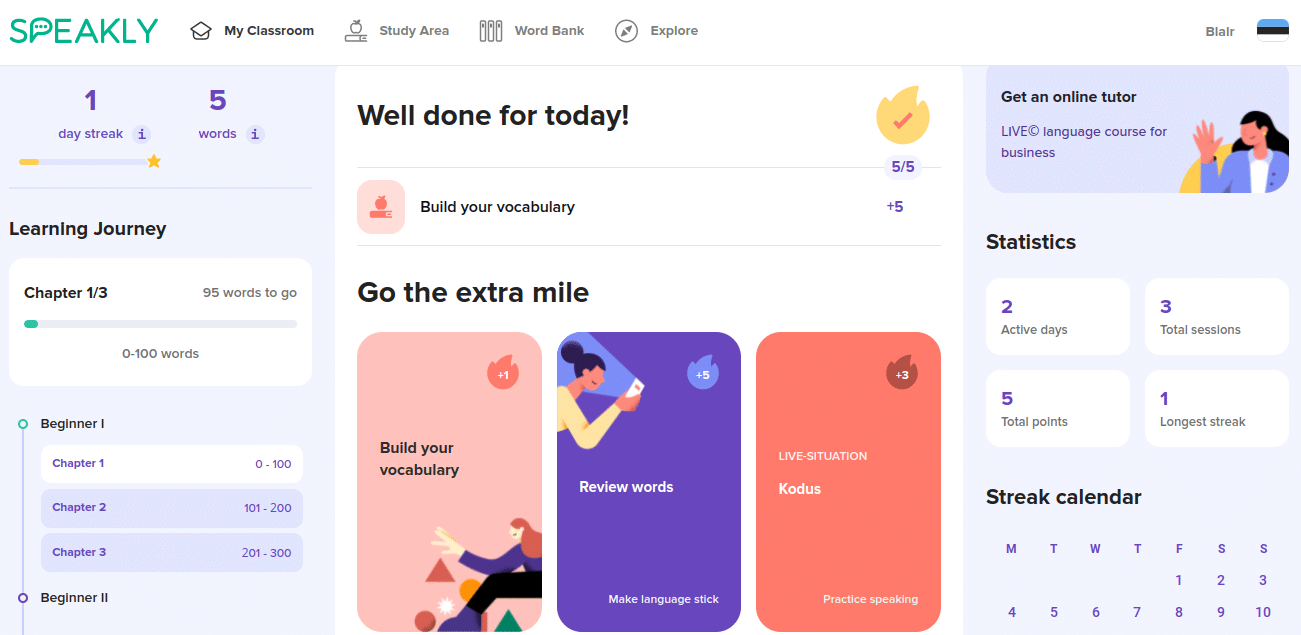
Study Area — Learning New Words and Phrases Progressively
After selecting whether you’d like to focus on communicating or writing or a combination of both (which the app asks before each lesson), you move onto learning new words. I’ve always chosen to have a focus on understanding and speaking, because I’m learning Estonian to get around the country, and I won’t need to do much writing.
As a beginner, the program sets you up with a goal of 100 words to learn before you move on to the next beginner level. You can’t skip forward until you complete the previous levels.
When you open the Study Room section of the site or app, you are immediately introduced to a new phrase, with a key word or phrase marked in orange text. You are first introduced to the phrase without a translation, and also without any photo or illustration. Then you click to move on, and the English translation is revealed as an audio clip of the phrase plays. So you get to hear and see the word or phrase in both English and Estonian, while hearing it spoken by a native speaker.
From here, you can move on to the next phrase, or you can “star” the phrase for further review, click to hear the phrase again, or click the grammar button for an explanation of any grammatical issues occurring in the phrase in English. I actually find these explicit grammar explanations quite helpful, but they could use more examples.
This process goes on until you’ve completed your current level, which takes about 5-10 minutes in my experience.
Mixed in with learning new words, you are also given multiple choice questions. For example (below), I’m asked to give the Estonian translation of “that’s.”
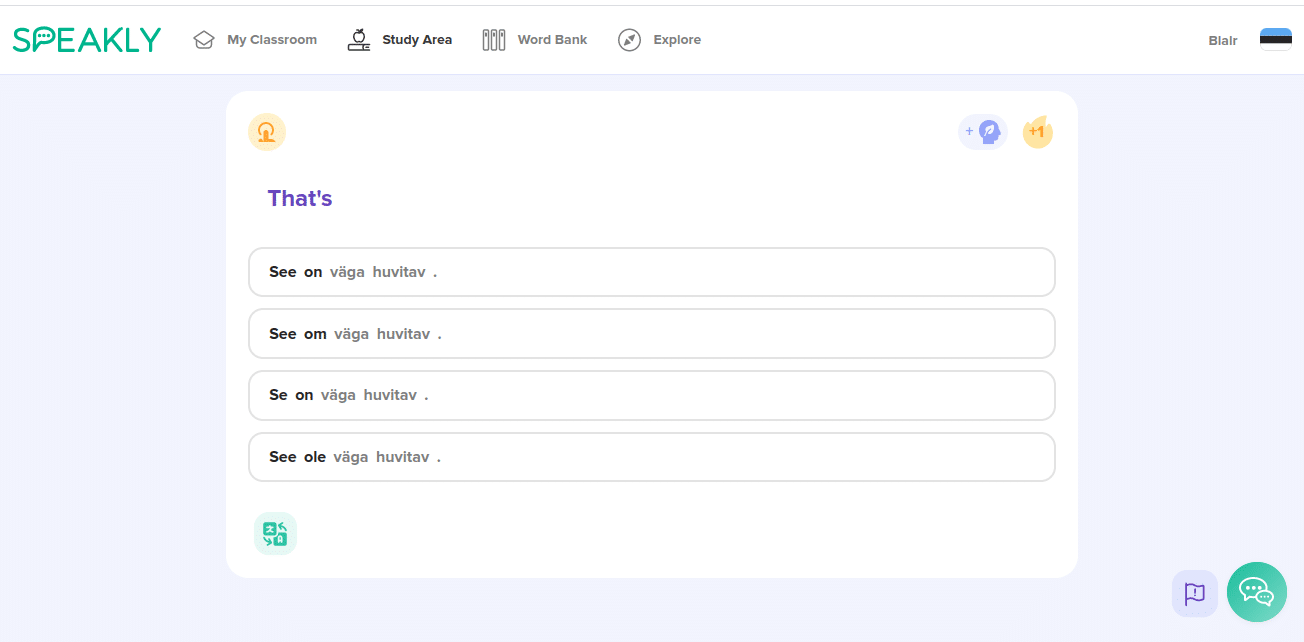
The process pretty much continues on like this. You’re given review words and phrases mixed in with new words and phrases, so you’re always slowly advancing. This is the spaced repetition element of this program.
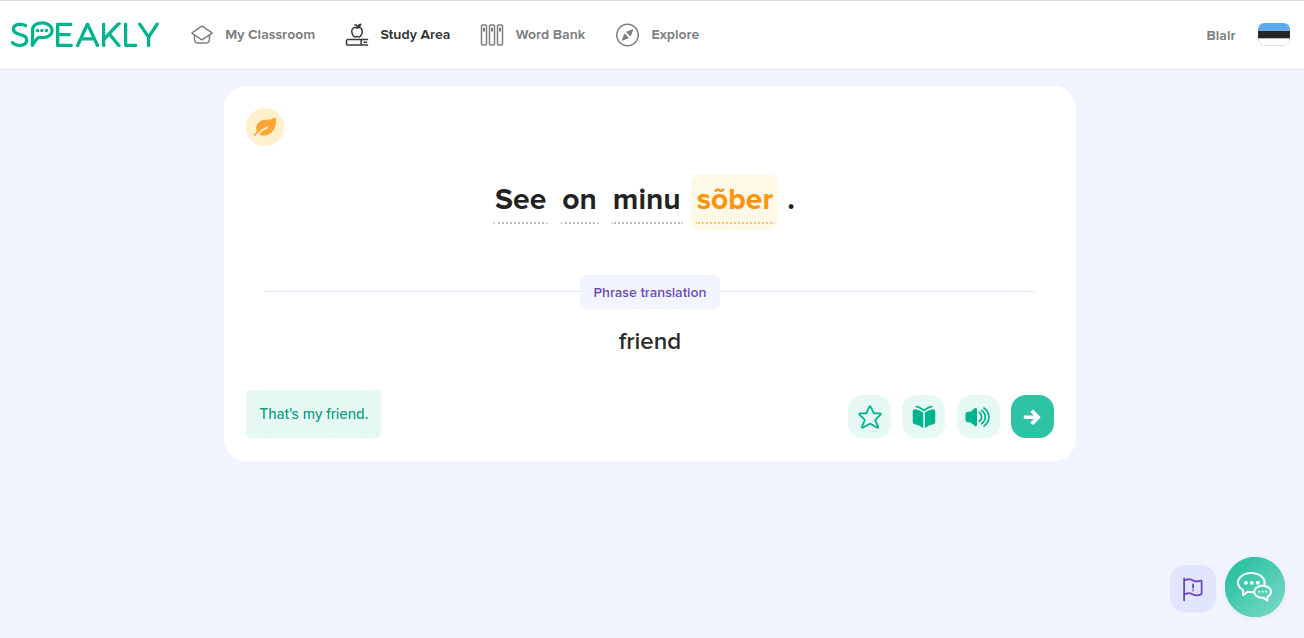
Word Bank — Review Words and Phrases
Speakly keeps a running list of all the words and phrases you’ve learned, so you can refer back to them anytime to review. This was very helpful for me, especially with being a beginner in a language that I basically knew nothing about. I found the words and phrases hard to remember, but after reviewing them in the Word Bank multiple times, I started to get some down.
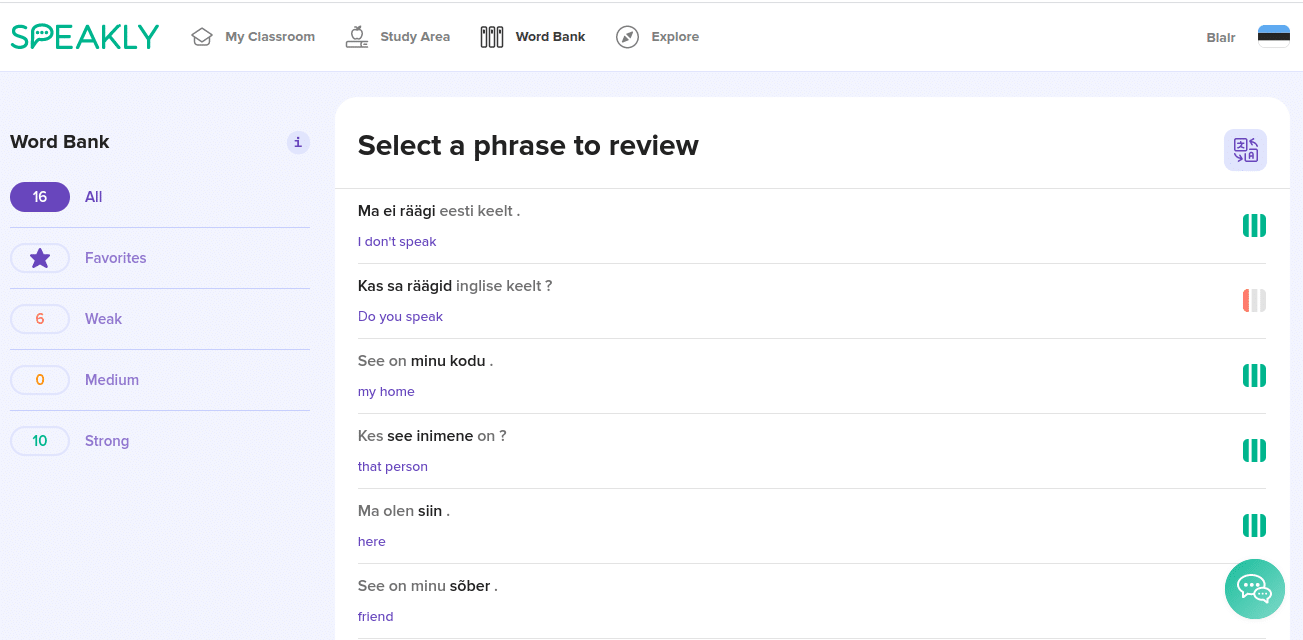
In the Word Bank, you can choose flashcards or listening to review the words. I found the flashcards function much more helpful because I don’t really have a good grasp on Estonian pronunciation yet.
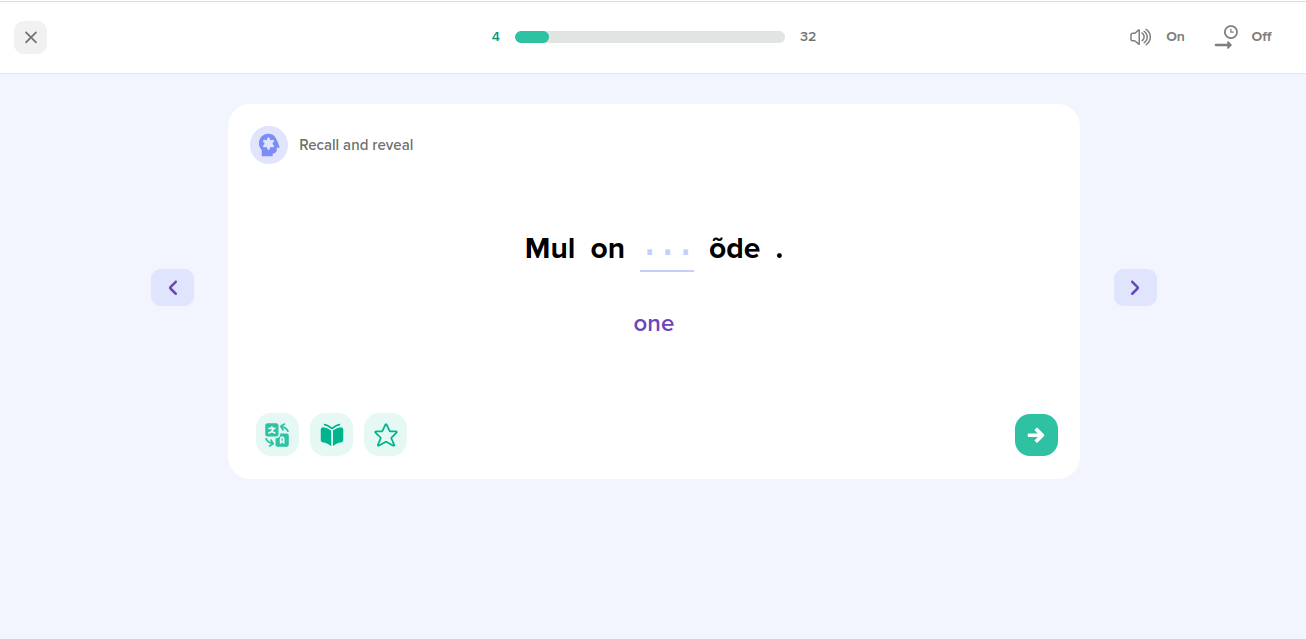
LIVE-Situations, Music Playlist and Listening Exercises
LIVE-Situations are activities that are meant to resemble real life language interactions you may face on the street or on the phone in Estonia. They’re basically typical conversations that are presented like text messages between two people, with audio.
For example, someone calls you and says “hi.” You have to reply, so the activity guides you to say “hello” back and then helps you with hints, which are essentially certain letters filled in of the Estonian word for hello. If you can’t get it, more letters are revealed, or the whole word is revealed as audio plays of the word.
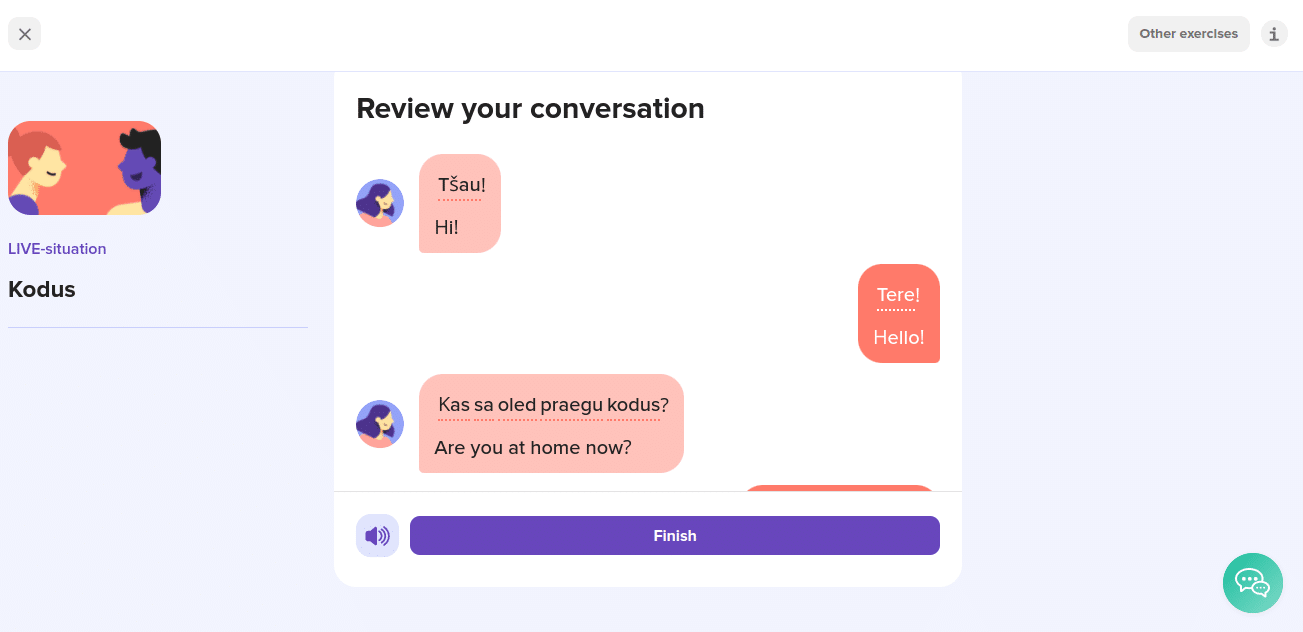
There are also more traditional listening exercises, in which you read along to an Estonian text (with or without English translation) as a speaker reads the text.
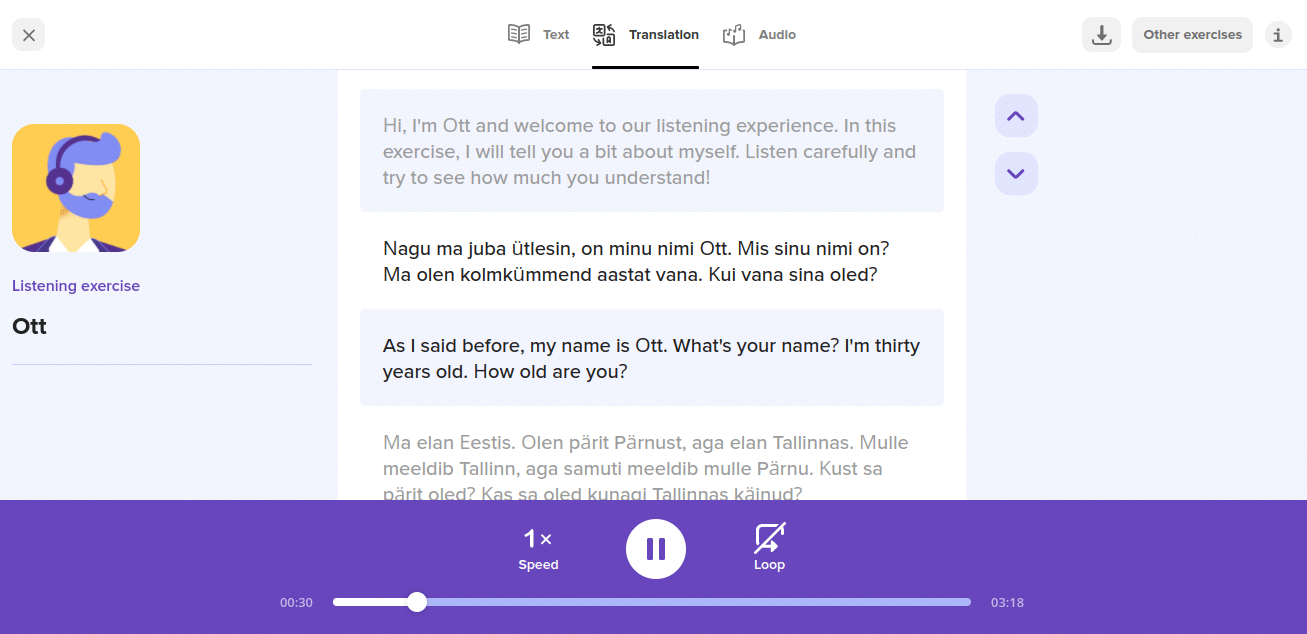
Last, there’s a fun Estonian music playlist, but Spotify Premium is required to hear them (or you can simply cut and paste the titles into YouTube, which is what I did.) A tip that I used with the music is to find lyric videos, so you can follow along to the lyrics, seeing the words as they’re sung.
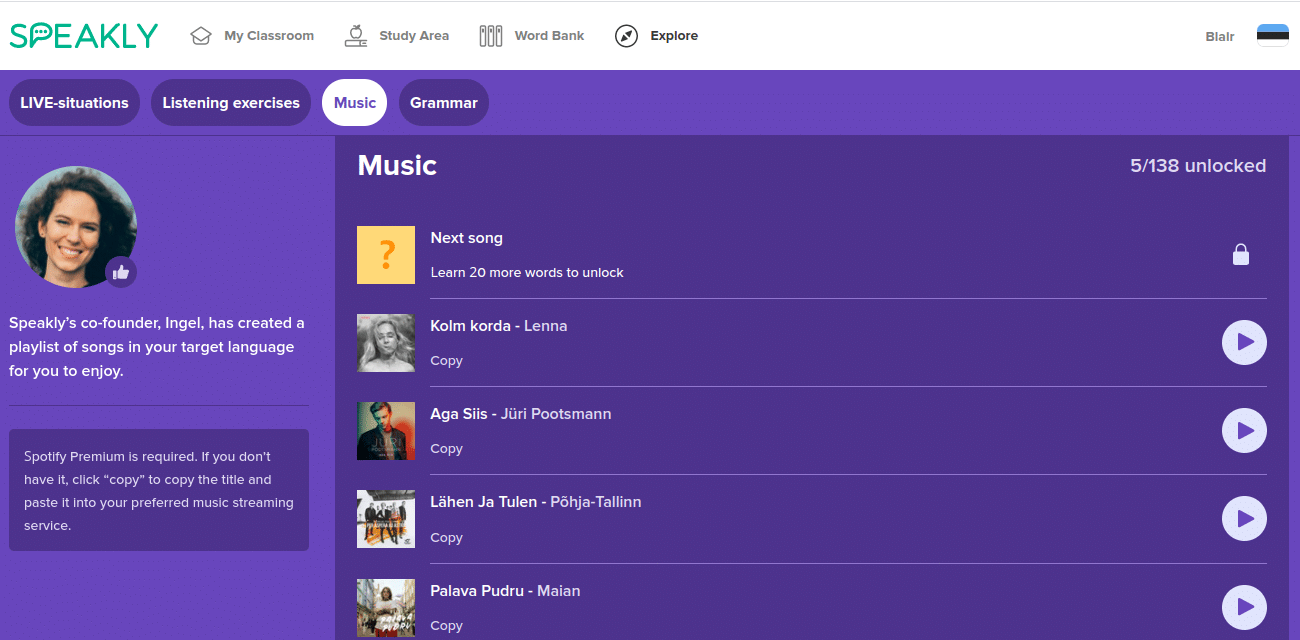
The Pros of Speakly
There’s a lot to like about Speakly. It’s super simple, easy to use and it gets you started right away on usable sentences that could help you navigate around a country in which the target language is spoken. Here are some of my favorite aspects to the Speakly approach:
Uncommon Languages Offered
I’ve never seen Estonian offered by a language app, but a quick Google search showed me that I’m wrong about this. Drops, italki and Ling have limited Estonian options, although none of these is as thorough and complete in the language as Speakly. The same goes for Finnish, although Duolingo does have a Finnish option, too.
Speakly is the top class best of the bunch for these unusual languages, and since Speakly was developed in Estonian in Estonia, you know that you can trust the accuracy of the program.
Music Playlist
One thing I really love about this program is the chance to stop learning new words and phrases and just sit back and listen to a song in Estonian (or Finnish, Russian, Spanish, French, Italian, German or English).
This helps to make the program more fun and it makes it less stressful, too, by giving you a break from learning new words in the Study Room.
And even though I’m including this as a pro for Speakly, I do wish there was a way to interact more with the music. Maybe a quiz after about the song’s vocabulary or something like that would make this section feel deeper and more interactive.
To make listening to these songs more effective for me, I copied and pasted the songs’ titles into YouTube and found lyric videos, so I could follow along as the song played. I did notice almost immediately that I recognized a few key words after just a few days on the app.
User Friendly
I figured since this app was Estonian, a tech-savvy country where you can vote and pay your taxes online, the technical aspects of this program would be excellent. And I wasn’t wrong there.
It’s super easy to use and I encountered zero bugs and zero confusion. In fact, I was using the program and learning Estonian within one minute of signing up, which was also super easy.
The user experience seems to encourage you to poke around and explore the site’s features at your own pace, going back to the main lessons in the Study Room whenever you’d like, so for an independent learner like me, that’s perfect.
Communicative Focus
The program immediately starts you out with key words and phrases that you need to get around. Words and phrases like “hello,” “thank you very much,” “no thanks” and “I’m ____.”
These words and phrases are chosen because they’re the most used in the language, according to statistical analysis done by Speakly.
I appreciated this as I was learning, because most of the phrases are ones that I could use in my first couple days in Estonia.
Affordably Priced
I think $9.99 a month (or $139.99 lifetime access) is super affordable for all you get with this program. What I really love is that there are many, many sections from beginner all the way up to advanced that can keep you busy for a long, long time.
Another aspect of why I think this app is super fair in terms of pricing is because you get all eight languages for the same fee. Because of this, I’ve been switching over to Spanish to freshen up my español skills a bit, too, when taking a break from Estonian.
I assume that as time goes on, the content will just be developed more and more as languages are filled out and the program evolves.
The Cons of Speakly
There are also some aspects of Speakly that I thought could be improved in order for it to be the holistic language learning program that it claims it is. Here are my main Speakly cons:
Lacks in Visual Elements
I found myself yearning for photos, illustrations and other graphic elements. Although Speakly is well designed and pleasing to look at, it’s strangely lacking in visual elements.
Even the people icons that appear in the LIVE-Situation texts are rather vague and somewhat boring.
I get that this is done on purpose so you can focus on the language, but I found myself missing the cute illustrations and characters of apps like Duolingo, the vivid color photographs of Rosetta Stone, or the color video of FluentU.
As I worked my way through the beginner levels, I even started noticing that the color palette in general is rather pale and I was craving some brighter colors.
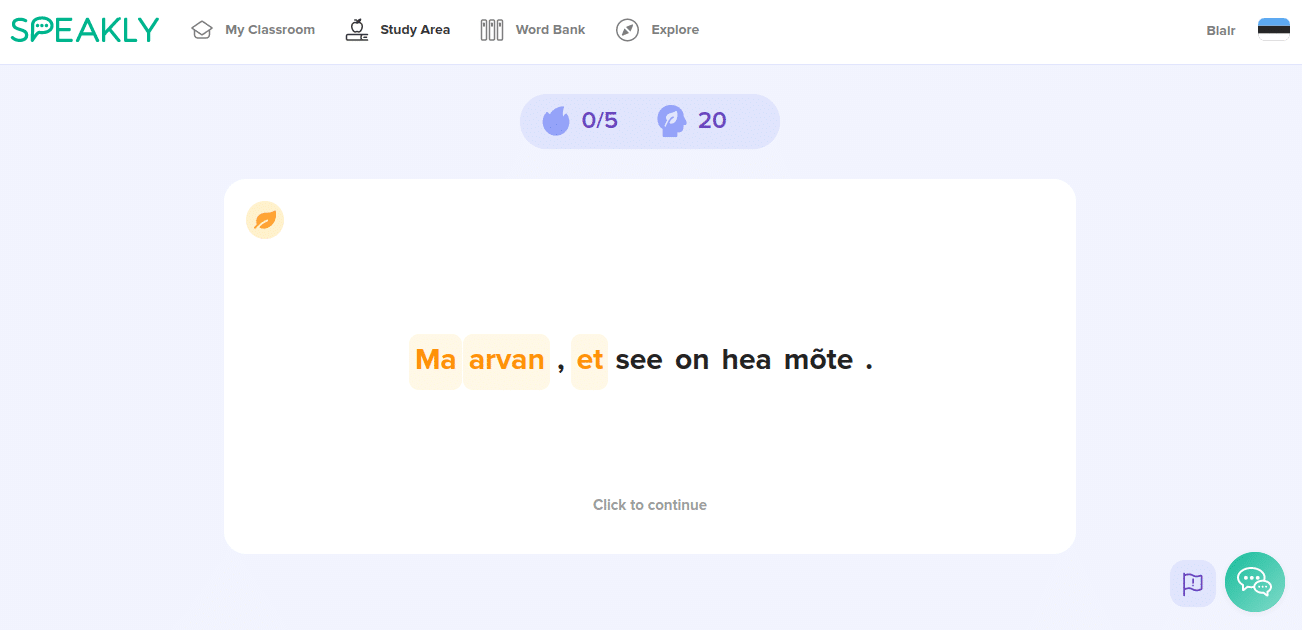
No Video Content and Not Enough Authentic Media
I don’t know about you, but I really like watching videos, whether that be movies, TV shows or vlogs. Because of that preference, I also like to have videos in my language learning. Because of this, it’s too bad that Speakly lacks any video content.
This is where I’d have to recommend supplementing Speakly with another language learning program that focuses on videos like FluentU.
What I love about FluentU is that you get to spend time watching authentic videos (movie trailers, vlogs, etc.), but each video you watch turns into a language learning lesson, because they all have super accurate interactive subtitles and even quizzes afterwards, so you can feel confident you understood the video.
For me, video is super important, so I would prefer to use a language learning program that has a lot of video, so if you go with Speakly, definitely supplement it with something like FluentU.
Can Become Repetitive
The Study Room section, which is the bulk of this learning program, can get a little repetitive. There is some variation in the exercises as you move from hearing and seeing new words and phrases to multiple choice questions, but that’s pretty much the formula that keeps coming up as you advance.
It’s up to you to vary the learning styles by choosing the other sections: listening exercises, LIVE-Situations, music or review. But the program never suggests these alternatives; you have to decide to do them on your own, which for me, meant that I kept forgetting about them and not using them as much as I should have.
But even in the other sections, such as LIVE-Situations, the program is designed for you to repeat the exercises three times each. I think if they designed just slightly different scenarios that include the same lessons, it would be more fun to do.
Steep Learning Curve
I know that many language apps (and teachers for that matter) like to introduce words in phrases or full sentences, so they’re in context, but I personally like to learn a few key words on their own before they appear in a sentence.
Speakly does introduce some words on their own, such as tere (hello), almost every other word was introduced within the context of a sentence. The problem with this approach for me, especially as a beginner, is that I usually didn’t know any of the other words in the sentence, so the learning curve felt steep for me.
Grammar Feels Like an Afterthought
Although the grammar in Speakly is all there, the way it’s designed as an extra feature, rather than integrated into each activity, making it feel like an afterthought.
For example, when I was going through the various grammar lessons, I learned that Estonian has 14 — yes 14! — grammatical cases, which influence how nouns, verbs, adjectives and more are formed.
But had I not opened the Grammar section, which is just written lessons with no interactive features, I wouldn’t have been explicitly informed of this. Which may have influenced whether or not I stuck with Estonian!
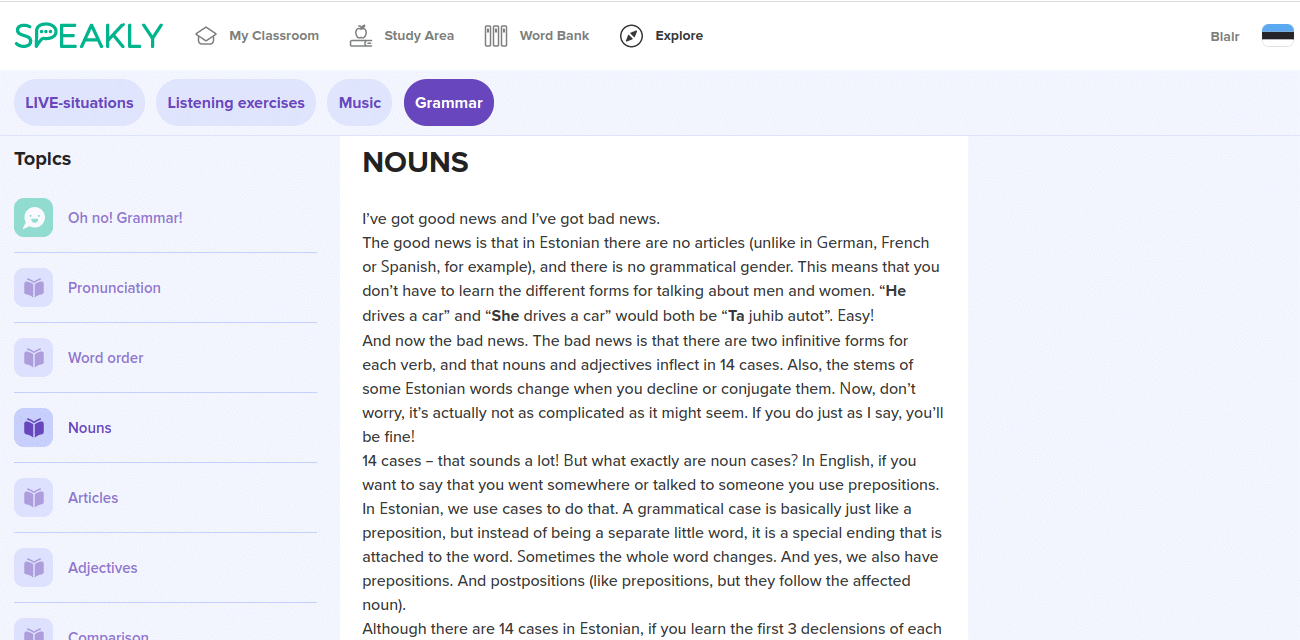
Some Skills Aren’t Thoroughly Covered
Writing, unless you specifically choose it at the start of a lesson, isn’t covered. Also the skills of reading and speaking aren’t given much either.
After a couple weeks of using Speakly, I don’t really feel like I could spell the Estonian words that I remember. This could be because I’ve only ever studied Romance languages like Spanish and Italian before this, which tend to be easy to spell languages, but the double, triple and more of the same vowels of Estonian and lots of umlauts in words like töööö (working night) really throws me off, and not having a chance to write them means that I don’t remember them very well. Is that three ös or four?
Speakly Versus Other Programs
All language learning programs have their advantages and drawbacks, so I thought I’d compare Speakly with some of the most popular language programs available today. Here’s how they match up:
Speakly vs. FluentU
Since one of the features I most missed while using Speakly was video, I wanted to start this comparison section with FluentU, which has video at the heart of its program.
I don’t know how many times I’ve heard from foreign friends (non-native English speakers) who’ve told me that they learned English through watching movies (and TV shows and skateboarding videos, etc.). In fact, I’ve heard it so many times, I definitely believe it.
FluentU works really well for me because I’m a person who really likes to watch movies, TV, music videos, news and vlogs on YouTube already. So it feels like a really sustainable and fun way to learn and review a language and it’s worked really well for me.
I find myself spending hours on FluentU, all while feeling engaged, while 15 minutes sometimes felt like a lot on Speakly because of its dryer learning style.
Overall, I’d choose FluentU here, but I really think FluentU and Speakly would complement each other nicely, and the cost would still be pretty affordable. If you pay the annual route for FluentU, you could have both programs for about $30 a month.
Speakly vs. Duolingo

I mentioned Duolingo in this review because one of the elements that I was missing the most while using Speakly was the fun colors and other visual elements like illustrations that Duolingo has. Comparing Speakly to Duolingo, Duolingo also has some (actually way more) unusual languages, with choices such as Finnish, Hawaiian, Navajo, Ukrainian and Hebrew.
I think that Duolingo is more fun and more gamified, and that cute little bird is always encouraging you (some would say pestering you), but for more serious types, Speakly might feel like a better fit.
Here’s our full review of Duolingo.
Speakly vs. Drops

I figured Drops would be good to compare to Speakly for two main reasons: it’s one of the few other apps that covers Estonian, and second, it’s also a spaced repetition vocabulary app.
Drops is more gamified-feeling than Speakly and it doesn’t feel like a holistic learning program; rather it’s a supplementary app that you can use in addition to whatever main program you’re using.
Drops limits each session to five minutes, and if you want premium content (anything above beginner level), it actually costs more than Speakly at $13 per month.
Overall, I’d choose Speakly in this match-up. You get the vocabulary plus a bunch of other stuff for a lower price.
Here’s our full review of Drops.
Speakly vs. Ling
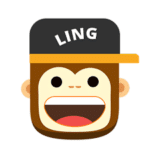
Ling, which is based in Thailand, has the same stated goal as Speakly: to teach the words, phrases and sentences that you really need in a language. Ling also uses spaced repetition like Speakly.
The app also has Estonian, Finnish and a lot of other less common languages like Nepali, Mongolian, Lao, Bosnian, Latvian and more. Overall, there are 60 languages currently on the program.
But I found myself confused by some of Ling’s example sentences and word choices. I thought to myself: would I ever say this? No. They’re often too formal, or just not useful.
Also, Ling doesn’t teach the writing system of the languages that use them. If you can’t read Thai, for example, you’re going to be very lost as a beginner. The program does have fun visuals though, which beats Speakly in that regard.
Lastly, Ling is good for beginners, but sometimes lacks content for advanced learners. Speakly excels in content for advanced learners, so if you’re advanced and they have your language, go Speakly. Ling is a good option for those other 52 languages at $14.99 a month, $79.99 a year or $149.99 for lifetime access.
Speakly vs. Rosetta Stone

Rosetta Stone has those vivid photographs that really make a huge difference for me. They have 25 languages on offer, but they don’t offer Estonian or Finnish like Speakly does.
While Rosetta Stone teaches words and phrases in context like a native speaker would learn their own language, Speakly uses more English and explicit explanations of grammar and translations of words, phrases and sentences.
This, for me, makes Speakly more of an “adult” language learning program. You can immerse yourself in your target language, but you can also get a well written explanation of a grammatical concept in your own language to make sure you know what’s going on. I like that personally, since I’m not actually a child.
Here’s our full review of Rosetta Stone.
Is Speakly Worth It?
Pricing
Speakly gives three quite affordable options for paying:
You can pay $9.99 per month, $47.99 per year or you can pay $139.99 for full lifetime access. All of these levels include all of the program’s eight languages.
They also offer a seven-day free trial.
Here’s a link to Speakly’s payment page.
Final Verdict
Speakly does what it says it does and it’s backed up with research about which words are used most, but I couldn’t help feeling like the other apps’ language learners may have been having more fun than I did while using Speakly. Nevertheless, it did seem to work well and I did learn quite a lot of Estonian in a short period of time.
Because of that, even though I personally was missing some of the fun visual and video content that some other apps have (I’m thinking of FluentU and Duolingo here), I would still recommend Speakly if they cover the language you’re looking to learn.
The app is truly solid and functions perfectly. The same goes for the desktop version of Speakly. What it lacks in visual and video content, it makes up for with a serious, research-backed learning approach that I really appreciated.
If Speakly adds video content and more authentic content in the future, to keep up with the competition, I would recommend it even more, but until that day, I’d say it’s best to use Speakly with a complementary program like FluentU, so you can vary your learning activities more and build a sustainable path to fluency.
And One More Thing...
If you dig the idea of learning on your own time from the comfort of your smart device with real-life authentic language content, you'll love using FluentU.
With FluentU, you'll learn real languages—as they're spoken by native speakers. FluentU has a wide variety of videos as you can see here:
FluentU has interactive captions that let you tap on any word to see an image, definition, audio and useful examples. Now native language content is within reach with interactive transcripts.
Didn't catch something? Go back and listen again. Missed a word? Hover your mouse over the subtitles to instantly view definitions.
You can learn all the vocabulary in any video with FluentU's "learn mode." Swipe left or right to see more examples for the word you’re learning.
And FluentU always keeps track of vocabulary that you’re learning. It gives you extra practice with difficult words—and reminds you when it’s time to review what you’ve learned. You get a truly personalized experience.
Start using the FluentU website on your computer or tablet or, better yet, download the FluentU app from the iTunes or Google Play store. Click here to take advantage of our current sale! (Expires at the end of this month.)






